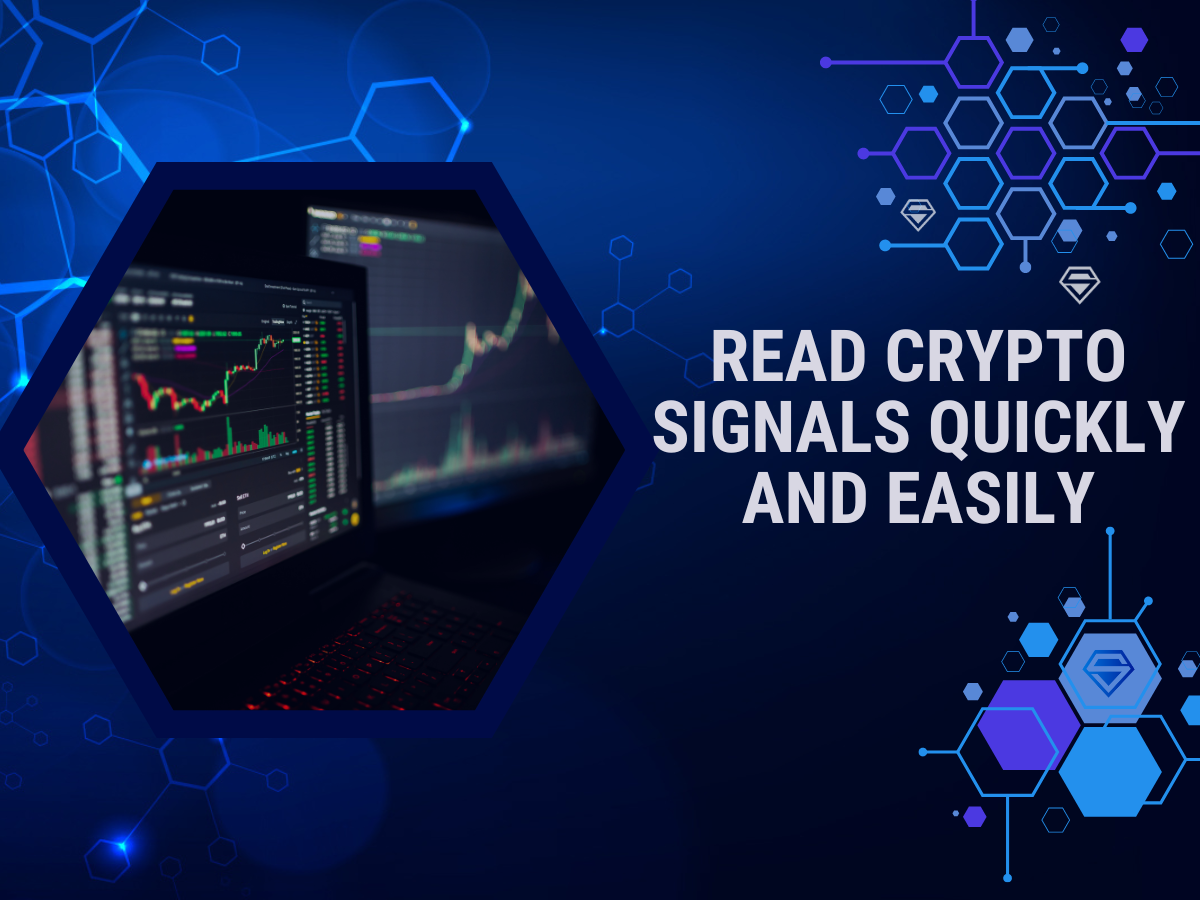
31. May, 2024
How to Read Crypto Trading Signals: A Quick and Easy Guide
The ability to interpret trading signals can make all the difference in your investment strategy.
Crypto trading signals are essentially buy and sell recommendations provided by experienced traders and analysts. These signals can serve as valuable guidance for both novice and seasoned investors navigating the volatile crypto markets.
This guide aims to provide you with a quick and easy approach to understanding and using crypto trading signals effectively. We’ll cover the basics of what trading signals are, how to find reliable sources, and most importantly, how to read the information they provide.
What are Crypto Trading Signals?
Crypto trading signals are recommendations provided by experienced traders and analysts to help investors decide when to buy or sell specific cryptocurrencies.
These signals are intended to help investors make more informed decisions about when to enter or exit a particular cryptocurrency position.
The key components of a crypto trading signal typically include:
- Asset Identification: The specific cryptocurrency or trading pair being recommended for a buy or sell action.
- Entry/Exit Prices: The suggested prices at which to enter or exit the trade.
- Market Timeframe: The time period (e.g., short-term, medium-term, long-term) the signal is intended to be acted upon.
- Rationale: The analysis and reasoning behind the buy or sell recommendation, which may include factors such as technical analysis, market trends, news events, or other market-related insights.
How does Crypto Trading Signals Work?
Crypto trading signals work by providing investors with specific recommendations on when to buy or sell a particular cryptocurrency. The process typically involves the following steps:
- Signal Generation: Experienced traders, analysts, or specialized signal providers analyze the cryptocurrency markets using a combination of technical analysis, fundamental analysis, and market sentiment data. This analysis leads to the generation of buy and sell signals for various cryptocurrencies.
- Signal Dissemination: The generated signals are then shared with investors through various channels, such as Telegram channels, messaging services, or dedicated trading signal providers. These signals are often accompanied by detailed information, including the cryptocurrency, entry/exit prices, and the rationale behind the recommendation.
- Signal Evaluation: Investors receiving the trading signals need to evaluate the information and decide whether to act on the recommendations. This evaluation process may involve cross-checking the signals with other market data, assessing the credibility of the signal provider, and aligning the signals with their own investment strategies and risk tolerance.
- Trade Execution: If an investor decides to act on a trading signal, they will then execute the recommended trade, either by buying or selling the specified cryptocurrency at the suggested entry or exit prices.
- Signal Performance Tracking: Investors can monitor the performance of the trading signals they have followed, analyzing the accuracy and profitability of the recommendations over time.
Take note that the effectiveness of crypto trading signals largely depends on the quality of the analysis, so make sure you choose reliable and credible signal providers.
What You Need to Know to Learn How to Read Crypto Trading Signals
To effectively read and interpret crypto trading signals, there are several key things you need to know. Firstly, it’s essential to have a strong understanding of technical analysis techniques, such as chart patterns, candlestick formations, trendlines, support and resistance levels, and technical indicators.
Secondly, it’s crucial to recognize the importance of market sentiment. The overall sentiment in the cryptocurrency market can be influenced by various factors, including social media activity, news events, and investor sentiment. Understanding how changes in market sentiment can impact the interpretation of trading signals and price movements.
Additionally, it’s important to evaluate the credibility, track record, and methodology of the crypto trading signal providers you plan to follow. Always check recommended premier crypto signal providers so they align with your overall investment strategy and risk management plan.
How Do You Read Crypto Patterns?
Reading crypto trading patterns is an essential skill for interpreting and acting upon crypto trading signals.
Here’s a step-by-step guide on how to read common crypto trading patterns:
Identify Candlestick Patterns
Candlestick charts are widely used in cryptocurrency trading to visualize price movements over time. Look for recognizable candlestick patterns, such as the bullish engulfing pattern, the hammer, or the doji, as they can signal potential price reversals or continuations.
Analyze Trendlines
Identify the overall trend direction by drawing trend lines that connect the higher lows (uptrend) or lower highs (downtrend). Observe how the price interacts with these trendlines, as breakouts or retests of the trendlines can indicate potential trend changes.
Identify Support and Resistance Levels
Determine the key support and resistance levels by identifying areas where the price has had difficulty breaking through in the past. Monitor how the price reacts when it approaches these levels, as they can act as potential turning points for the market.
Examine Trading Volume
Analyze the trading volume patterns alongside the price movements to confirm the strength and validity of the price trends. Significant changes in trading volume can signal increased market interest or the exhaustion of a trend.
Recognize Chart Patterns
Familiarize yourself with common chart patterns and forex indicators, such as the head and shoulders, double tops/bottoms, or triangles, as they can indicate potential price reversals or continuations. Pay attention to the formation and breakouts of these patterns to anticipate future price movements.
Consider Technical Indicators
Utilize technical indicators, such as moving averages, the Relative Strength Index (RSI), or the Stochastic Oscillator, to confirm and validate the trading signals. Observe how the price and these indicators interact to gain a more comprehensive understanding of the market’s dynamics.
How to Get Free Crypto Trading Signals?
Now that you know how to read crypto trading signals, you might want to put that into practice! Here are some tips where you can get free crypto trading signals and learn how to read them:
- Follow Crypto Influencers and Analysts: Many experienced crypto traders and analysts provide free trading signals and market insights through their social media channels, such as Twitter, Telegram, or YouTube.
- Join Crypto Trading Communities: Participate in online crypto trading communities, forums, and subreddits, such as r/CryptoMarkets or r/CryptoSignals. These communities often share free trading signals, analysis, and market discussions among members.
- Utilize Free Signal Providers: There are several websites and crypto signal groups that offer free crypto trading signals.These platforms may provide basic buy and sell recommendations, along with some technical analysis and market insights.
- Use Free Crypto Trading Bots: Explore free crypto trading bots that can generate and execute trading signals automatically based on predefined algorithms. Some popular examples include 3Commas, Shrimpy, or Cryptohopper, which offer limited free functionalities.
- Sign Up for Free Trials: Many paid crypto trading signal providers offer free trials or limited-time access to their services. Take advantage of these offers to test the quality and accuracy of their signals before committing to a paid subscription.
Wrapping Up: Are Crypto Signals Accurate?
When it comes to crypto trading, many investors turn to crypto signals to help guide their investment decisions. But the question remains: how accurate are these crypto trading signals?
The accuracy of crypto signals can vary greatly, as they are influenced by a variety of factors. Factors such as the provider’s methodology, market conditions, and your own risk management approach can all impact the effectiveness of the signals.
To improve the accuracy of your crypto trading signals, it’s important to focus on how to read crypto trading signals effectively. This involves understanding technical analysis, recognizing market sentiment, and aligning the signals with your investment strategy.
Remember, while crypto signals can be a valuable resource, it’s important to do your own research, diversify your portfolio, and manage your risk carefully.


